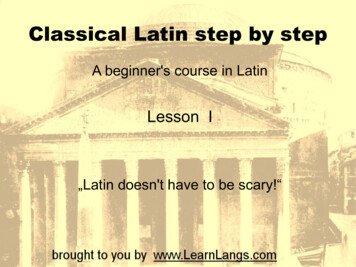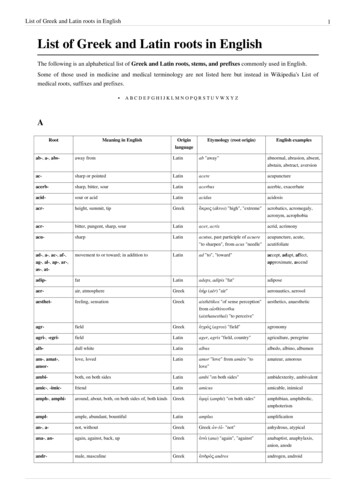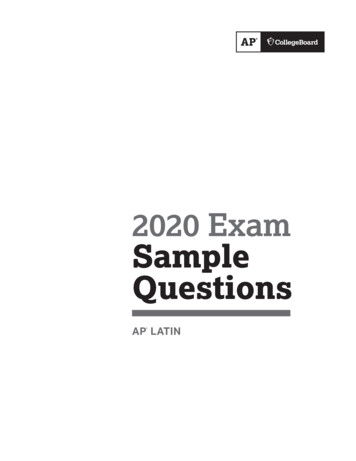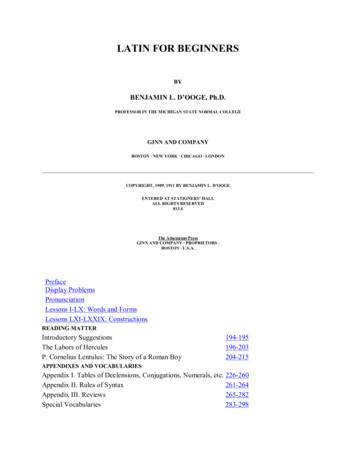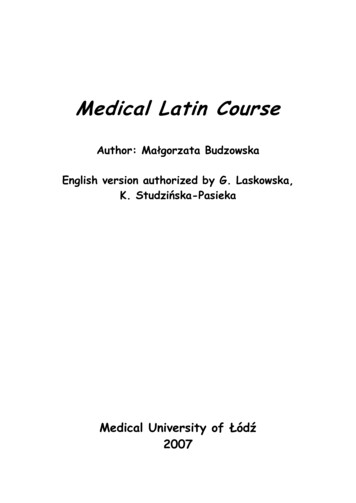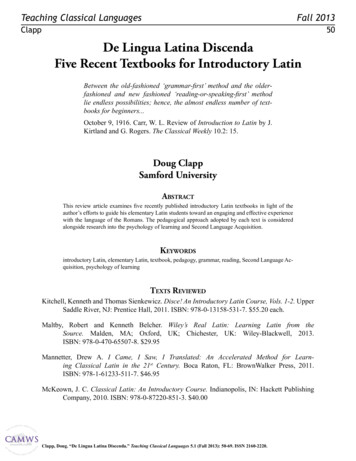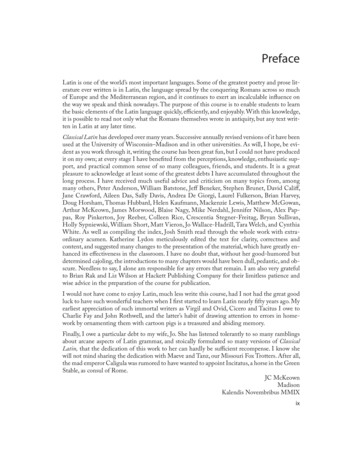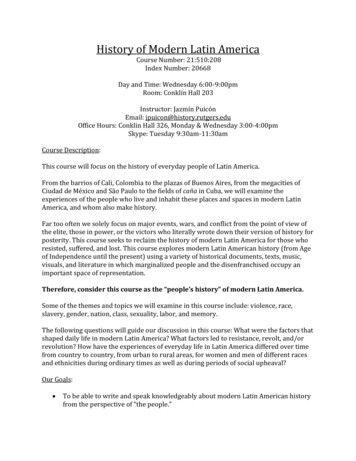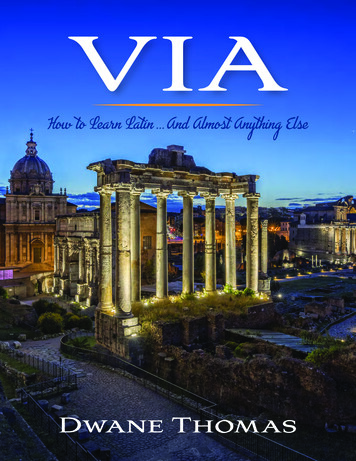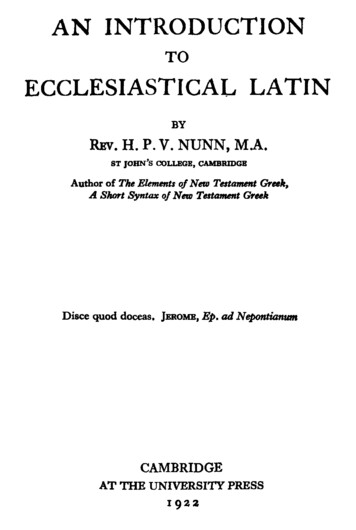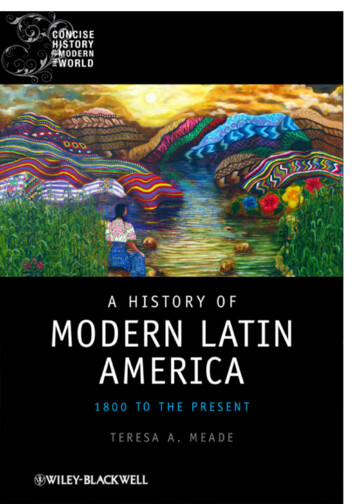
Transcription
ContentsList of FiguresList of MapsPrefaceAcknowledgmentsAbout the cover image1 Introduction to the Land and Its PeopleGeographyPeopleEconomiesPoliticsCulture and EntertainmentLatin America: Past and Present2 Latin America in 1790Colonial BackgroundPower and PrivilegeLand2
Colonial AdministrationEnlightened MonarchyThe Agents of the ReformDisorder and RebellionDiscontent and Disorder in BrazilChanging Gender RolesOn the Road to IndependenceNationalism and American CultureConclusion3 Competing Notions of FreedomFive Roads to IndependenceAfrican Slavery in the AmericasSlavery and the CountrysideSlavery in the CitiesTreatment and PunishmentSlavery and the ChurchAfrican Medicine and Religious Practices3
Resistance and RebellionThe Sugar Colony of Saint-DomingueThe Slave RevoltThe Revolution BetrayedBrazil’s Independent EmpireIndependence in MexicoSouth American IndependencePost-independence Changes in Racial and Gender StatusThe Last Holdout of Slavery in Spanish AmericaLatin America in a Changing World OrderConclusion4 Fragmented NationalismsSearching for Political and Economic UnityNew World “Feudalism”Post-independence PoliticsArgentina and the TyrantsPopulist Caudillismo: Paraguay and Bolivia4
After CaudillismoRace, Race Mixture, and LiberalismGender and LiberalismIntersections of Gender, Race, and ClassNationalismConclusion5 Latin America’s Place in the Commodity ChainThe Guano BoomNitrates in ChileSugar and CoffeeThe Growth of São PauloColombian CoffeeThe Rubber BoomExpanding ExportsMexico and US ExpansionismThe North American InvasionGeneral López de Santa Anna5
The New Age of ImperialismCentral America and the Panama CanalEcuador and the “Panama” HatIndependence at Last? Cuba and Puerto RicoConclusion6 Immigration, and Urban and Rural LifeAsian ImmigrationEuropean ImmigrationThe Southern ConeLife on the PampasBritish InvestmentThe Changing Cultural LandscapeUrban RenewalMexico and Benito JuárezFrench InvasionsThe Rise of Porfirio DíazIntellectual Theories: Positivism and Eugenics6
Conclusion7 Revolution from Countryside to City: MexicoThe PorfiriatoOpposition to the PorfiriatoConstitutional OppositionMadero AssassinatedUS InterventionWomen in CombatCarranza as PresidentThe Constitution of 1917Aftermath of StruggleAgrarian Revolts in Latin AmericaConclusion8 The Left and the Socialist AlternativeSocialism on the World StageSocial Reform and the Middle ClassAnarchism, Socialism, and Anarcho-syndicalism7
Women in the WorkforceColombia: Resistance to the United Fruit CompanyThe Labor MovementSocialism and the ArtsTenentes Revolt and Brazilian CommunismModern Art Week in BrazilWomen in the ArtsSocialism vs. CapitalismJosé Carlos MariáteguiConclusion9 Populism and the Struggle for ChangeGetúlio Vargas and “New State” PoliticsJuan Perón and PeronismPerón’s Fall from GracePolitics EngenderedRevolutionizing Mexico: Lázaro CárdenasPopulism in Colombia and Peru8
Central AmericaThe Long Twentieth CenturyConclusion10 Post-World War II Struggles for SovereigntyWorld War IITemporary Worker ProgramPost-war Latin AmericaMilitary vs. Civilian RuleThe Absolute Dictator: Rafael TrujilloAmericas in Transition: Guatemala and BoliviaGuatemalaRevolution in BoliviaMining and the Voice of Bolivian ActivismThe Revolution in DeclineConclusion11 Cuba: Guerrillas Take Power“History Will Absolve Me”9
Causes for DiscontentThe Revolutionary WarThe Special Period in PeacetimeCuba and the WorldErnesto “Che” GuevaraWhat Difference Did the Revolution Make?Democratic ShortcomingsConclusion12 Progress and ReactionModernization and ProgressBrazil’s Military CoupThe National Security StateLatin America’s Youth MovementMexicoThe Massacre at TlatelocoThe Chilean Road to SocialismThe Chilean Road to Socialism Dead Ends10
Urban Guerrilla Warfare: UruguayUrban Guerrilla Warfare: ArgentinaDictatorship and State TerrorMothers of the Plaza de MayoThe War of the Malvinas/Falkland IslandsMovements for Revolutionary Change: PeruSendero Luminoso, The Shining PathWomen and Shining PathRepression and FujimoriConclusion13 Revolution and Its AlternativesA Changing Catholic ChurchMarxism and Catholic HumanismThe OppositionThe Somozas versus Sandino: the Next GenerationThe Sandinista OppositionSandinistas in Power11
United States and the SandinistasEffects of the Contra WarCentral America in Turmoil: El Salvador and GuatemalaPolitics of Repression in El SalvadorThe OppositionThe Fighting EndsGuatemala: The Bloodiest WarThe Evangelical AlternativeColombia: The Longest WarThe War on Drugs in Latin AmericaConclusion14 The Americas in the Twenty-first CenturyThe Washington ConsensusBrazil and the Workers’ AlternativeThe Workers’ Party in PowerBolivia: Twenty-first-century IndigenismoVenezuela and Hugo Chávez12
The Bolivarian MissionChávez and “the Pink Tide”Complicating Social TiesChile’s Transition to DemocracyNew Social MovementsMovements for Racial and Gender EqualityWomen and PoliticsThe Latin Americanization of the United StatesImmigration and Free TradeOpponents Confront Free TradeImmigration and NeoliberalismSharing the Environment and the Cost of StewardshipNotesGlossaryFurther ReadingIndex13
Concise History of the Modern WorldCovering the major regions of the world, each history inthis series provides a vigorous interpretation of its region’spast in the modern age. Informed by the latest scholarship,but assuming no prior knowledge, each author presentsdevelopments within a clear analytic framework.Unusually, the histories acknowledge the limitations oftheir own generalizations. Authors are encouraged tobalance perspectives from the broad historical landscapewith discussion of particular features of the past that mayor may not conform to the larger impression. The aim is toprovide a lively explanation of the transformations of themodern period and the interplay between long-term changeand “defining moments” of history.PublishedA History of Modern Africa: 1800 to the PresentRichard ReidA History of Modern Latin America: 1800 to the PresentTeresa A. MeadeForthcomingA History of Modern East AsiaCharles Armstrong14
Chosen Nation: A History of the American People since1886Maurice IssermanEurope since 1815Albert LindemannA History of Russia since 1700Rex Wade15
16
This edition first published 2010 2010 Teresa A. MeadeBlackwell Publishing was acquired by John Wiley & Sonsin February 2007. Blackwell’s publishing program hasbeen merged with Wiley’s global Scientific, Technical,and Medical business to form Wiley-Blackwell.Registered OfficeJohn Wiley & Sons Ltd, The Atrium, Southern Gate,Chichester, West Sussex, PO19 8SQ,United KingdomEditorial Offices350 Main Street, Malden, MA 02148-5020, USA9600 Garsington Road, Oxford, OX4 2DQ, UKThe Atrium, Southern Gate, Chichester, West Sussex,PO19 8SQ, UKFor details of our global editorial offices, for customerservices, and for information about how to apply forpermission to reuse the copyright material in this bookplease see our website at www.wiley.com/wiley-blackwell.The right of Teresa A. Meade to be identified as the authorof this work has been asserted in accordance with theCopyright, Designs and Patents Act 1988.17
All rights reserved. No part of this publication may bereproduced, stored in a retrieval system,or transmitted, in any form or by any means, electronic,mechanical, photocopying, recording or otherwise, exceptas permitted by the UK Copyright, Designs and PatentsAct 1988, without the prior permission of the publisher.Wiley also publishes its books in a variety of electronicformats. Some content that appears in print may not beavailable in electronic books.Designations used by companies to distinguish theirproducts are often claimed as trademarks.All brand namesand product names used in this book are trade names,service marks, trademarks or registered trademarks of theirrespective owners. The publisher is not associated with anyproduct or vendor mentioned in this book. This publicationis designed to provide accurate and authoritativeinformation in regard to the subject matter covered. It issold on the understanding that the publisher is not engagedin rendering professional services. If professional advice orother expert assistance is required, the services of acompetent professional should be sought.Library of Congress Cataloging-in-Publication DataMeade, Teresa A.A history of modern Latin America : 1800 to the present /Teresa A. Meade.p. cm. — (Concise history of the modern world)18
Includes bibliographical references and index.ISBN 978-1-4051-2050-0 (hardcover : alk. paper) —ISBN 978-1-4051-2051-7(pbk. : alk. paper) 1. Latin America—History. I. Title.F1410.M433 2010980—dc22200902796719
List of Figures1.1Presidents Evo Morales (Bolivia), Luiz Inácio Lula da Silva (Brazil),and Michelle Bachelet (Chile) at a meeting of the Union of SouthAmerican Nations, 20081.2Brazilian National Congress in the capital of Brasilia2.1The Execution of Túpac Amaru II2.2Eighteenth-century painting of the Last Supper, Cuzco Cathedral, Peru2.3The Virgin of Guadalupe2.4“Portrait of the Artist as the Virgin of Guadalupe”3.1Slaves carrying a woman in a sedan chair3.2The Runaway Slave (Neg Mawon or Marron Inconnnu), Port-au-Prince,Haiti4.1Plantation with house, barns, storage sheds and a row of slave cabins,ca. 1800s4.2“Cuba and Martí Present at the Moncada”5.1Slave men and women sorting and transporting coffee beans5.2Teatro Amazonas, Manaus, Brazil5.3Saint James the Great as a Moor-killer, wearing a “Panama” hat,seventeenth century5.4US President Theodore Roosevelt at the construction of the PanamaCanal5.5Uncle Sam to Porto Rico: “And to think that bad boy came near beingyour brother!”6.1Torii gate in the Japanese neighborhood of São Paulo, Brazil6.2Migration to Argentina, Brazil, Cuba, and Uruguay, 1871–19246.3Italian immigration to Argentina, 1871–19246.4Tango Dancers in San Telmo, Buenos Aires7.1Soldaderas in the Mexican Revolution7.2General Francisco Villa and Emiliano Zapata8.1Tenement patio in Valparaiso, Chile in 19008.2“Calavera of Adelita, a Soldadera,” José Guadalupe Posada20
9.1“Accepting the Monroe Doctrine”9.2Eva and Juan Perón at the Teatro Colón, Buenos Aires10.1 Squatter settlements on the outskirts of Buenos Aires10.2 Children’s playground in Buenos Aires squatter settlement11.1 Ernesto “Che” Guevara11.2 Near Plaza de la Revolución, Havana, Cuba12.1The Navy School of Mechanics, or ESMA (Escuela de Mecánica de laArmada)12.2 Mothers of the Plaza de Mayo, Buenos Aires, Argentina13.1 Sandinista barricade, Matagalpa, Nicaragua, 197914.1 Venezuelan President Hugo Chávez on USS Yorktown, Curação Harbor14.2Forensic anthropologist Isabel Reveco and Chilean Judge JuanGuzmán. 31614.3Presidents Cristina Fernández de Kirchner (Argentina) and MichelleBachelet (Chile), 200614.4 Origins of all immigrants to the United States, 200714.5Zapatista Subcomandante Marcos and Comandante Tacho, Chiapas,Mexico, 199914.6 “Chiles Rellenos Contra Hot Dogs,” by Francisco Verástegui21
List of Maps1.1The vegetation of South America1.2The countries of Latin America3.1The Atlantic slave trade, 1451–16003.2The Atlantic slave trade, 1601–17003.3The Atlantic slave trade, 1701–18103.4The Atlantic slave trade, 1811–18703.5Latin America in 18305.1Comparative size of Brazil5.2Mexican territory lost to the United States10.1 Latin America in World War II22
PrefaceThis book covers well over 200 years of Latin Americanhistory. It begins with a brief summary of Europeancolonialism, laying the groundwork for the succeedingchapters on the history of the independent nation-statesthat make up modern Latin America. Presenting such ahistory is not easy: Latin America is immense and diverse;events that have a huge impact on one nation or region(such as the US war with Mexico in the 1840s), may affectothers only tangentially, or not at all. Moreover, textbooksof this sort inevitably experience a crucial conflict. Thetext should present a broad, general interpretation thatmakes sense of many disparate details and events, yet it isimpossible to explore fully each and every eventundergirding the big picture. Another inevitable tension ischronology (time) versus topics, as well as time versusplace (country or region). Since historical events build onand grow out of whatever comes before and lead into andinfluence that which comes after, it is very difficult toextract a happening from its context, especially given themany cultural, social, economic, and political contextssurrounding every historical moment.Historians must always grapple with this dilemma ofpresentation: the author can stick to certain themes andrelay a general analysis fitted roughly into a chronology or,alternatively, can relate the history of one country, orgroup of countries, one at a time. The country-by-countryapproach is often more precise, but difficult to use in thestandard history class, while covering many nations in onefull sweep can become confusing. Ultimately it really23
doesn’t matter which approach is used if the end product isstripped of the fascinating stories and the lives of peoplewho contribute to the overall narrative.This book presents Latin American history as seen throughthe prism of social class, gender, race, and ethnicity.Specific historical events and trends – such as the slaverevolt in Haiti, the patriarchal rules governing marriage inBrazil, construction of the Panama Canal, or the MexicanRevolution – are explained according to this interpretiveapproach. The seemingly unconnected events in thehistories of Latin American societies come together in anarrative that is more than the sum of its parts; rather theparts, selected for their explanatory value, help usunderstand the whole. Thus I present examples of whattranspired in a single nation at a specific time asrepresentative of a wider phenomenon and to serve as awindow into the ideas, conflicts, social movements,cultural trends, and ascribed meanings that have made anappearance on Latin America’s historical landscape. Theresulting interpretation derives from a process of siftingand sorting through an immense amount of material;choices have been made as to what to include and, oftenwith terrible regret, what to leave out.Readers who seek a general level of analysis and broadhistorical narrative will find it here. The book refers to anddescribes major issues and events, drawing on manyvaluable texts, monographs, document sets, journalisticand fictional accounts of Latin America’s rich history. Atthe same time, it was often necessary to allow one event toserve as the archetypical illustration of important trends.For example, a discussion of Argentina’s labor movement24
is used to reflect the struggle between workers and ownersthat unfolded under specific conditions but also took placein many countries. Labor in other areas is then covered inbroad strokes, with the assumption that readers andinstructors will draw on other examples to fill out thenarrative. I settled on this approach after more than 20years of college teaching, mainly in a small liberal artsinstitution, where it soon became apparent that students arebetter able to grasp the big picture when given smaller,concrete incidents to exemplify the story on which thebroader interpretation is based. Relying solely on “bigtheories” and moving from country to country and event toevent makes students’ eyes glaze over and note-taking turnto doodling. Blame could be placed on poor training ingeography, the ethnocentrism of US society, the internet,or what have you, but the truth remains that we oftendevelop our understanding of history by building out froma specific example or single historical event. Similarly, thegeneralities of history often become clear when we focuson a concrete example, or a few examples, to illustrate thepoint.Finally, history is based on original sources. The particularinterpretation historians have drawn from those sources,even the conflicting conclusions they derive after lookingat the same or similar documents, is the heart and soul ofthe enterprise. Interspersed throughout this narrative arefirst-hand accounts, documents, and excerpts from fiction,displayed in boxes. These boxes have two purposes. Onthe one hand, they can serve as the basis of discussion in aclass; on the other, they demonstrate the kinds of materialshistorians draw on to construct a narrative, therebyallowing the reader of the text to critically judge the25
author’s interpretation. Although I am well aware thatreaders sometimes skip over this additional material,seeing it as irrelevant to the text, I am hopeful thatinstructors and students will pause to examine an originaldocument, a quirky historical fact, and a literary comment,in the course of reading the broader narrative. The use ofprimary sources allows the reader and the student ofhistory to take up the analytical process for her or himself.A Further Reading section at the end lists books chapter bychapter for ease of reference.In addition to documents and first-hand accounts, I havealso chosen to weave in historical, and also sometimesfictional, asides, from various authors, including theUruguayan Eduardo Galeano. Galeano compiled athree-volume “based on fact” fictional interpretation ofmajor events in the history of the Americas from thepre-Columbian period to the late twentieth century. He didthis, he anthropomorphized, because “Poor History hadstopped breathing: betrayed in academic texts, lied aboutin classrooms, drowned in dates, they had imprisoned herin museums and buried her, with floral wreaths, beneathstatuary bronze and monumental marble.”1As a historianand teacher, I naturally beg to differ a bit with hisconclusion, since those of us who teach and write strive topresent history as a lively narrative, not dull facts drownedin dates. However, Galeano is right when he exhorts us torescue history from hero worship and to question thesources, since neither they, nor the facts they present,“speak for themselves.” In his trilogy Memory of Fire,Galeano freely and provocatively writes the history of theAmericas. Drawing on documents, he creates a fanciful26
narrative of the past, which at points misses the mark andat others nails it precisely.In the end, we are all interpreters of history, trying to makesense of our own past and our place within the era inwhich we are living; and for that we rely on books and theexplanations contained within them. Although this Historyof Modern Latin America is a very small contribution tothat daunting enterprise, I hope readers will find the eventsand people who comprise the narrative of Latin America’spast interesting, the explanation of that historyunderstandable and enlightening, and the interpretationchallenging. History should be nothing less.27
AcknowledgmentsIn the course of writing this book, I have been assisted bymany colleagues whom I am happy to acknowledge.Christopher Wheeler, now at Oxford University Press, firsttalked to me about this project over a drink at theAmerican Historian Association conference where wediscussed our mutual admiration for the work of EricHobsbawm. I have never met Mr. Hobsbawm, but I wantto thank him for his many inspiring and profound insights,as well as Christopher and Tessa Harvey at Blackwell forthe conversation that pulled me into this book. Manythanks to Peter Coveney, my editor at Wiley-Blackwell,who saw the book through to completion, and to hisassistants Deirdre Ilkson and Galen Smith, whocompetently and cheerfully answered my millions ofqueries along the way. My special thanks to CarolineRichards for copyediting.Colleagues and friends in Latin America and the UnitedStates have assisted with comments, corrections, andencouragement. I especially want to thank Cecilia Belej,Susan Besse, Avi Chomsky, Alejandra Vassallo, BarbaraWeinstein, Ann Zulawski, and the anonymous readers fortheir insights, clarifications, and advice. Over the years Ihave accumulated a debt to my students at Union Collegewho worked as research assistants, proofreaders, typists,contributors, and critics: Nancy Borowick, HeatherCunningham, Colin Foard, Kelvin Martinez, Stacy Paull,Jazmin Puicon, and Jessica Simpson. I especially want tothank Jane Earley for her assistance with this book, theUnion College Faculty Development Grant for research28
and travel funds, and the librarians of Schaefer Library forhelp tracking down sources.Alison Raphael applied her copyediting wizardry to thefirst draft and improved the prose. Working with Alison,whom I have known since the mid-1970s when we metresearching our dissertations in Rio de Janeiro, was aspecial treat. My sister, Martha Meade, read the entiremanuscript from start to finish, offered comments based onher years of teaching high school history and caught anumber of errors. My family, Darren, Claire, and AndorSkotnes, provided expertise with computers, photographs,and technical and editorial advice. Andor, especially, I cannever thank enough.It is impossible to acknowledge all the people whocontributed to this book, mainly because the process ofwriting a textbook draws on the resources of an entireprofession. My debt is primarily to the many scholars whohave explored, analyzed, photographed, mapped, andcharted the history of Latin America. Compiling anarrative from mountains of books, articles, web pages,and news articles was both an inspiring and a humblingexperience. The scholarship on Latin America is trulyimpressive; whatever errors and inadequacies remain inthis text are my own.29
About the cover imageThe painting on the cover is Cánto a la Naturaleza (Songto Nature) by Paula Nicho Cumes, an indigenousKaqchikel Maya Indian from San Juan Comalapa. One ofthe foremost Maya female artists in Guatemala today,Nicho Cumes’ work is noted for original and unusualthemes, reflective of an authentic, self-taught, style.For more about Paula Nicho Cumes and other Mayaartists, see the web site http://www.artemaya.com/.30
1Introduction to the Land and Its PeopleLatin America is a vast, geographically and culturallydiverse region stretching from the southern border of theUnited States to Puerto Toro at the tip of Chile, thesouthernmost town of the planet. Encompassing over 8million square miles, the 20 countries that make up LatinAmerica are home to an estimated 550 million people whoconverse in at least five European-based languages and sixor more main indigenous languages, plus African Creoleand hundreds of smaller language groups.Historians disagree over the origin of the name “LatinAmerica.” Some contend that geographers in the sixteenthcentury gave the name “Latin America” to the new landscolonized by Spain and Portugal in reference to theLatin-based languages imposed on indigenous people andimported African slaves in the newly acquired territories.More recently, others have argued that the name originatedin France in the 1860s under the reign of Napoleon III, as aresult of that country’s short-lived attempt to fold all theLatin-language-derived countries of the Americas into aneocolonial empire. Although other European powers(Britain, Holland, and Denmark) colonized parts of theAmericas, the term “Latin America” generally refers tothose territories in which the main spoken language isSpanish or Portuguese: Mexico, most of Central and SouthAmerica, and the Caribbean islands of Cuba, Puerto Rico,and the Dominican Republic. The former Frenchpossessions of Haiti and other islands of the Caribbean,31
French Guiana on the South American continent, and evenQuebec in Canada, could be included in a broadeneddefinition of Latin America. However, this book definesLatin America as the region that fell under Spanish andPortuguese domination beginning in the late fifteenth andinto the mid-sixteenth centuries. The definition alsoencompasses other Caribbean and South Americancountries such as Haiti and Jamaica among others, sinceevents in those areas are important to our historicalnarrative. This definition follows the practice of scholars inrecent years, who have generally defined Latin Americaand the Caribbean as a socially and economicallyinterrelated entity, no matter what language or culturepredominates.GeographyLatin America boasts some of the largest cities in theworld, including four of the top 20: Mexico City, SãoPaulo (Brazil), Bogotá (Colombia) and Lima (Peru). Whendefined by greater metropolitan area – the city plusoutskirts – Buenos Aires (Argentina) and Rio de Janeiro(Brazil) join the list of the world’s megacities, the term fora metropolis of more than 10 million people. Populationfigures, however, are controversial since most of thesegigantic urban centers include, in addition to the housedand settled population, transitory masses of destitutemigrants living in makeshift dwellings or in the open air. Itis hard for census takers and demographers to obtain anaccurate count under those circumstances.Not only does Latin America have some of the largestpopulation centers in the world, but its countryside,32
jungles, mountains, and coastlines are major geographicaland topographical landmarks (see Map 1.1). The2-million-square-mile Amazon Basin is the largestrainforest in the world. Spanning the far north of Brazil,stretching into Bolivia, Peru, Ecuador, Colombia, FrenchGuiana, Guyana, Suriname, and Venezuela, it is home forapproximately 15 percent of all living species on theplanet. South and to the east of the Amazon Basin in theBrazilian state of Mato Grosso lays the Pantanal, theworld’s largest wetlands. Other superlatives include thehighest mountain range of the Americas (the Andes) thatstretches nearly the entire length of the continent; secondin the world to the Himalayas of Asia in height, the Andesare much longer, geologically younger, and veryseismically active. The Andean peak Aconcagua in Chileis the highest mountain in the Americas, which at 22,834ft. exceeds Dinali (Mt. McKinley) in Alaska by over 2,000ft. The Atacama Desert, spanning Argentina, Bolivia, andChile, is the driest place on earth and the largest depositoryof sodium nitrates on the planet. Elsewhere in the Andeanregion is Lake Titicaca, the most elevated navigable bodyof water in the world. This huge lake forms the boundarybetween Peru and Bolivia, and the Bolivian city of La Pazis the world’s highest-altitude capital city. Angel Falls inVenezuela is the highest waterfall in the world; at 3,212 ft.it is almost 20 times higher than Niagara Falls. Angel Fallsconnects through tributaries to the world’s largest river (involume), the Amazon. In its 25,000 miles of navigablewater, this mighty “River Sea,” as the Amazon River iscalled, contains 16 percent of the world’s river water and20 percent of the fresh water on Earth.People33
The sheer diversity of the population of Latin America andthe Caribbean has made the region extremely interestingculturally, but has also affected the level of economic andpolitical equality. Latin America is exceedingly diverse, aplace where the interaction, cross-fertilization, mutation,interpenetration, and reinvention of cultures from Europe,Asia, Africa, and indigenous America has produced alively and rich set of traditions in music, art, literature,religion, sport, dance, and political and economic trends.Bolivia, for example, elected an indigenous president in2005 who was a former coca leaf farmer. President EvoMorales won easily with the backing of poor andindigenous Bolivians but has met hostility from wealthyand middle-class citizens who benefited from the country’snatural gas exports and follow more “Western” traditions.Thus ethnic and racial strife has accompanied synthesisand cultural enrichment as cultures continue to confronteach other more than 500 years past the originalfifteenth-century encounter. (See Map 1.2.)Map 1.1 The vegetation of South America. (CourtesyCathryn L. Lombardi and John V. Lombardi, LatinAmerican History: A Teaching Atlas, ca. 1983. Bypermission of The University of Wisconsin Press.)34
In Bolivia and Peru people who trace their ethnicity backto the pre-Columbian era constitute the majority, while inColombia, Ecuador, El Salvador, Guatemala, Honduras,Mexico, Nicaragua, Panama, Paraguay, and Venezuelapeople of mixed European and indigenous ancestry, knownas mestizos, constitute the majority. Africans wereimported as slaves from the sixteenth until themid-nineteenth centuries, and their descendants stillcomprise over half of the population in many areas. Peoplein the Caribbean islands of Cuba, the Dominican Republic,and Puerto Rico, as well as in many South Americannations, especially Brazil, are descendants of a mixture ofAfricansandEuropeans,calledmulattosor35
Afro-descendant, a more appropriate term that refers toheritage rather than race. Blacks are in the majority inHaiti and in many of the Caribbean nations that were in thehands of the British, Dutch, French, or other colonialpowers. Everywhere in Latin America there is evidence ofracial mixture, giving rise to the term casta, which theSpaniards used to denote any person whose ancestors werefrom all three major ethnic groups: indigenous, European,and African. Although this has a pejorative connotation insome regions, the creation of such a term suggests thatracial mixture in Latin America is so extensive as to makeit often awkward, and imprecise, to list each combination.Large numbers of Europeans immigrated to Latin Americain the late nineteenth and early twentieth centuries. Inaddition to the majority who came from Spain, Portugal,and Italy, immigrants arrived from France, Germany,Poland, Russia, and the Middle Eastern countries ofTurkey, Syria, and Lebanon; a large number of EasternEuropean and German Jews sought refuge in LatinAmerica both before and in the years immediately afterWorld War II. Many European migrants settled in theSouthern Cone countries of Uruguay, Argentina, Chile,and the so
1.2 The countries of Latin America 3.1 The Atlantic slave trade, 1451–1600 3.2 The Atlantic slave trade, 1601–1700 3.3 The Atlantic slave trade, 1701–1810 3.4 The Atlantic slave trade, 1811–1870 3.5 Latin America in 1830 5.1 Comparative size of Brazil 5.2 Mexican territory lost to the United Stat
